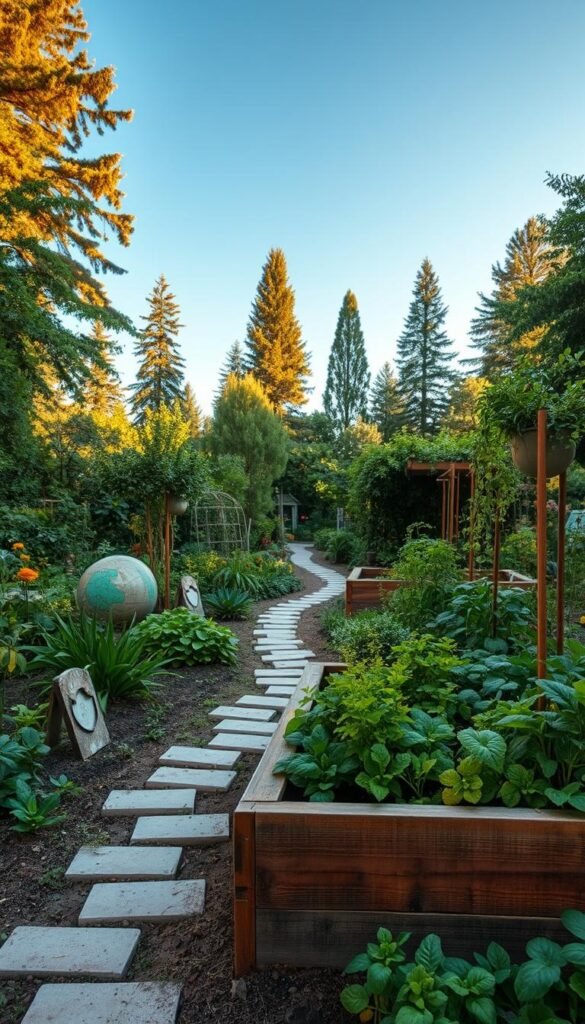Your backyard holds endless potential to become a reflection of your personality. With thoughtful planning and hands-on effort, you can craft an inviting retreat that blends beauty with practicality. Simple projects like building raised beds or crafting decorative pathways let you shape every corner without professional help.
Start by evaluating your space. Consider sunlight patterns, soil quality, and how you want to use the area. Maybe you’re dreaming of a cozy fire pit zone or a vibrant flower border. Sketch ideas that match your lifestyle while keeping maintenance manageable.
Affordable materials like reclaimed wood or native plants help stretch your budget. Mix textures and colors to create visual interest – think stone accents beside flowing grasses or bright containers against green shrubs. These choices add character while supporting local ecosystems.
This guide will show you how to balance creativity with functionality. Learn to repurpose everyday items into unique focal points, from vintage teacup bird feeders to mosaic stepping stones. You’ll gain confidence to tackle projects that turn ordinary yards into extraordinary spaces.
Understanding Your Garden Space
Every yard has its own personality shaped by sunlight, soil, and existing features. Start by walking your garden at different times to spot sunny patches, shady corners, and drainage patterns. These observations become your roadmap for choosing plants and planning layouts that work with nature, not against it.
Sunlight Secrets and Soil Stories
Track how light moves across your space using a free app or old-fashioned notes. Most veggies need 6+ hours of sun, while ferns thrive in dim spots. For soil health, try the jam jar test – mix soil with water, shake, and see how layers settle. Sandy? Clay? Your plants will tell you what they need.
Blueprint Basics
Sketch your area on graph paper, marking trees, slopes, and water sources. One gardener discovered a hidden microclimate near their shed – perfect for growing citrus in chilly zones! Note where puddles form after rain or where wind whips through. These details help avoid costly mistakes later.
“A good map turns problems into possibilities,” says Oregon landscaper Mia Torres. Whether you’re creating a pollinator paradise or cozy seating nooks, understanding your garden’s unique character makes every project smoother.
Defining Your Garden’s Purpose and Style
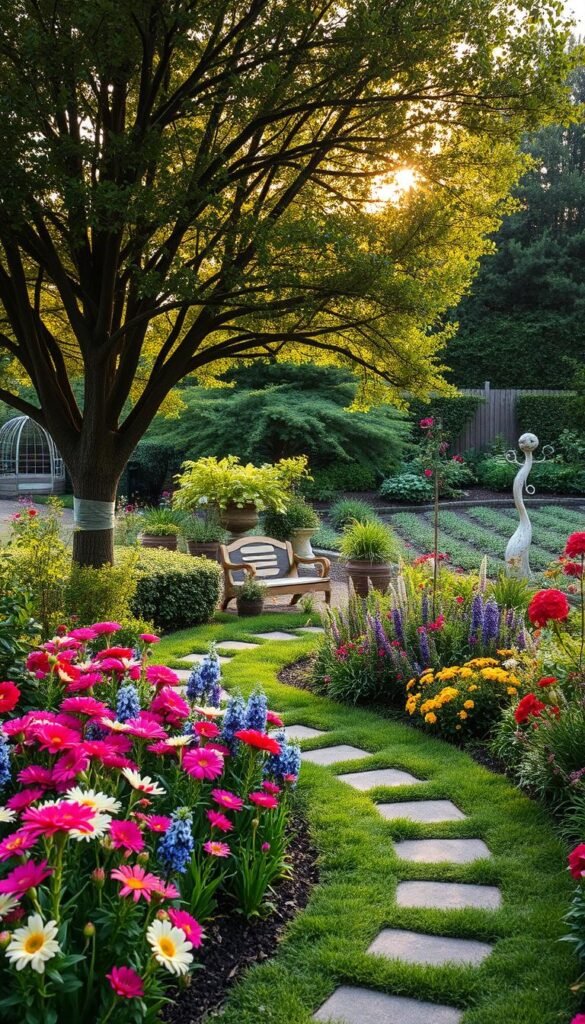
Transform your outdoor area into a purposeful extension of your living space. Start by asking: Will this be your morning coffee spot, weekend barbecue hub, or tomato-growing haven? Jot down three core activities you want to support – this clarity shapes everything from plant choices to furniture layouts.
Smart Zoning Strategies
Divide your plot into activity-based sections using natural markers. A gravel path could separate your dining patio from herb beds, while tall grasses might screen a reading nook. Popular zones include:
- Social spaces with weather-resistant seating
- Quiet corners with aromatic plants
- Productive patches for vegetables
Match your style to your home’s architecture. A mid-century modern house pairs well with clean lines and drought-tolerant succulents, while farmhouse styles beg for climbing roses and vintage trough planters. Consider this comparison:
| Style | Key Features | Best For |
|---|---|---|
| Cottage | Mixed blooms, winding paths | Romantic settings |
| Modern | Geometric shapes, monochrome | Urban spaces |
| Xeriscape | Native plants, rock features | Dry climates |
Landscape architect Elena Carter notes:
“Your outdoor room should feel like the next logical step from your interior – if your living room has navy accents, echo that in planter colors.”
Keep maintenance in mind – busy households often thrive with evergreen shrubs and automated irrigation in high-useareas.
Setting a Practical Budget and Timeline
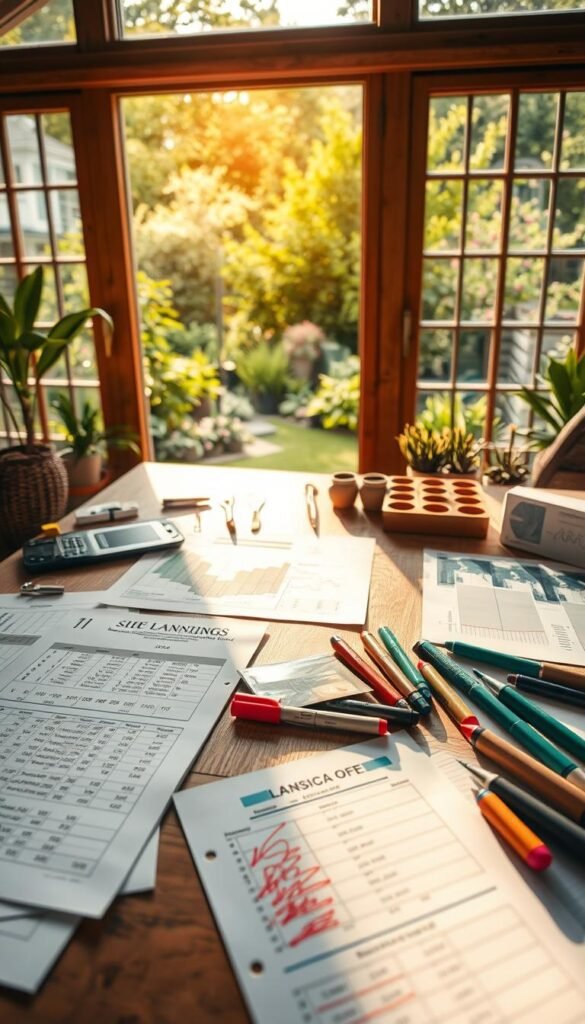
Smart planning turns landscaping dreams into reality. Start by asking: Which elements matter most right now? A clear roadmap prevents overspending and keeps projects on track through every season.
Cost Considerations for DIY Projects
Most hands-on upgrades fall into three tiers. Here’s what you might spend:
| Project Scale | Examples | Cost Range | Timeline |
|---|---|---|---|
| Small | Flower beds, container displays | $100-$500 | 1-3 weekends |
| Medium | Pathways, patio stones | $500-$2,000 | 2-6 weeks |
| Large | Decks, irrigation systems | $2,000-$10,000+ | 3+ months |
Phase your work to manage costs. Tackle quick wins first – paint old furniture, install solar lights, or define beds with edging. These instant gratification steps build momentum for bigger tasks.
Contractor Marissa Kwan advises:
“Allocate 15% extra for surprises – hidden roots under that pathway or specialty plants that catch your eye.”
Time your projects right. Lay pavers in dry weather, plant trees during dormancy, and split multi-step jobs across seasons. This staggered option lets you refine ideas as you go while keeping expenses manageable.
DIY Elements in Garden Design: Custom Features and Personal Touches
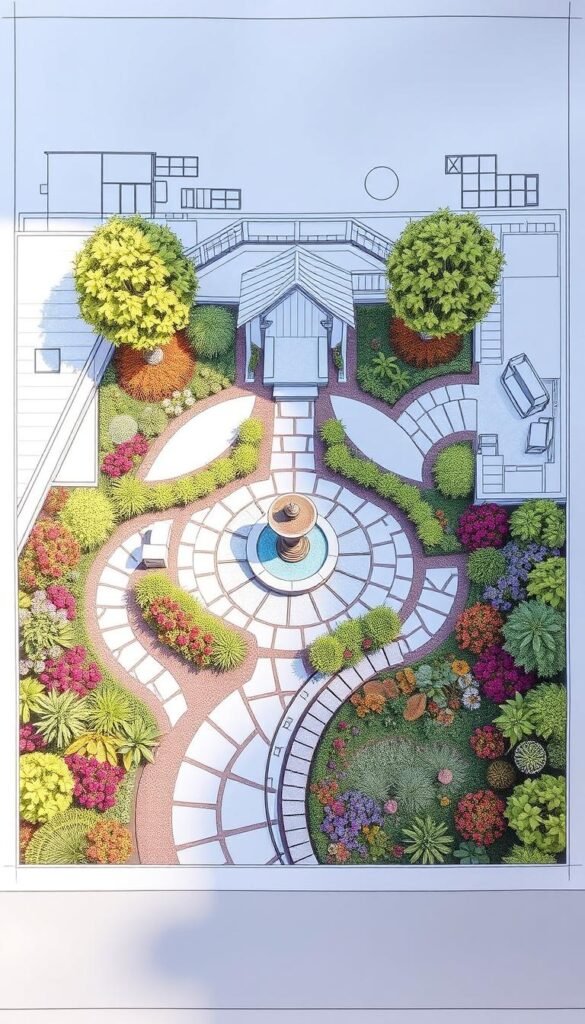
Your outdoor area becomes extraordinary when infused with what makes you smile. Start by sketching zones that match daily routines – morning tea spots might need wind protection, while evening gathering spaces benefit from ambient lighting. This planning stage ensures every feature serves both beauty and purpose.
Crafting Your Signature Layout
Mix practical elements with playful accents. Try these ideas:
- Turn old ladders into vertical herb planters
- Use broken ceramics for mosaic address markers
- Convert rain boots into quirky flower pots
Seasonal adjustments keep spaces fresh. Summer might showcase a handmade garden art display, while autumn welcomes pumpkin-lined paths. Local nurseries often offer workshops to boost your skills – perfect for creating custom plant markers or woven willow arches.
Landscape designer Theo James suggests:
“Let your space tell your story – that chipped teacup from Grandma makes a better birdbath than any store-bought piece.”
Track changes through photos. What started as simple stone borders could evolve into intricate pebble mosaics over time. These gradual upgrades let your garden grow alongside your creativity, becoming a living scrapbook of your journey.
Crafting Unique Focal Points and Garden Art
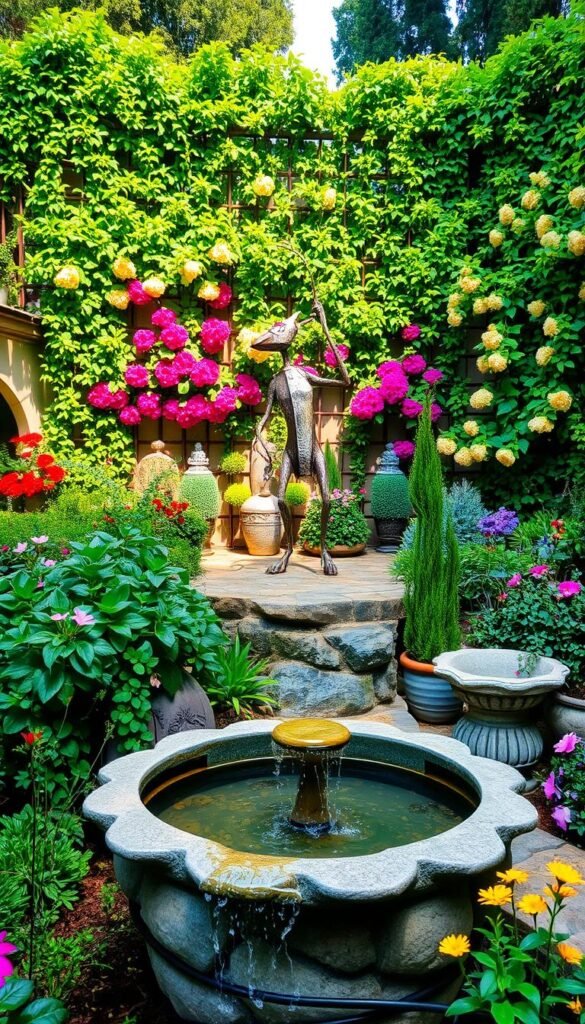
Transform ordinary corners into captivating showcases that anchor your outdoor space. A well-placed focal point acts like a compass – it guides the eye and creates rhythm in your layout. Think beyond store-bought statues: maybe a cluster of rusted watering cans spilling blooms, or a birch trunk carved into a spiral.
Water Features From Everyday Objects
Turn a stock tank into a bubbling oasis with a $20 submersible pump. Layer smooth river rocks at the base, then let water cascade over stacked terra-cotta pots. The trick? Position it where breeze-carried droplets won’t reach seating areas. You’ll gain soothing sounds without soggy cushions.
Sculptural touches needn’t cost a fortune. That twisted driftwood from last summer’s beach trip? Mount it vertically with climbing ivy. Old bicycle wheels become kinetic mobiles when hung between trees. Local artist Lila Moreno suggests:
“Let weather-worn objects tell their stories – lichen on stone or patina on metal adds depth no new decor can match.”
Placement matters most. Stand at your back door – where does your gaze naturally land? That’s prime real estate for garden art. Angle pieces to catch morning light or frame views from windows. A mosaic mirror propped in foliage multiplies floral beauty while creating illusions of space.
Remember: focal points work hardest when they pull double duty. A birdbath becomes a drinking station for pollinators. Stacked stones mark property lines artistically. Even functional items like rain barrels get personality upgrades with stenciled designs or trailing vines.
Utilizing Trellises and Vertical Structures
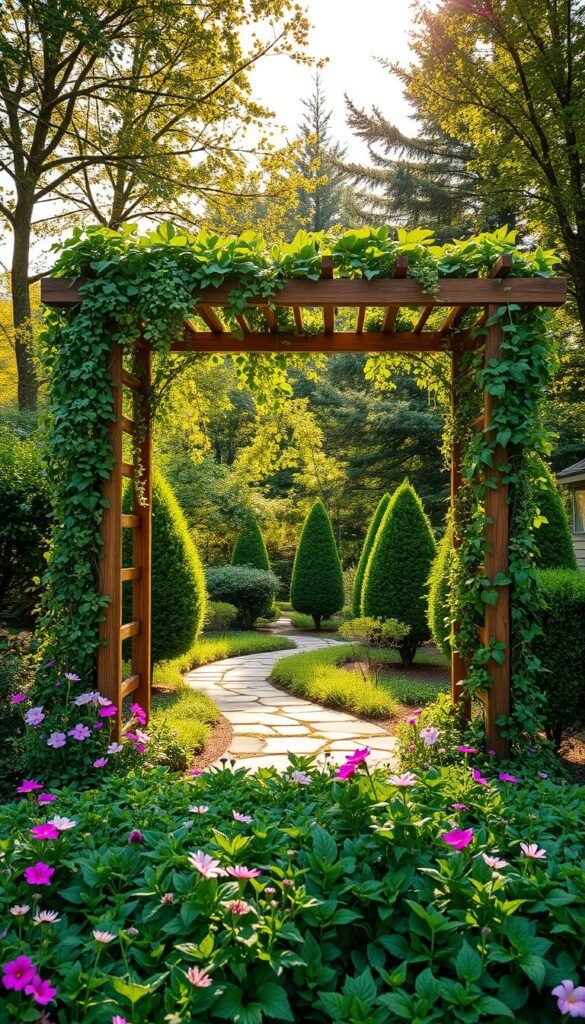
Elevate your garden’s potential by thinking upward. Vertical solutions solve two challenges at once: they make space for more greenery while adding sculptural charm. Whether you’re training tomatoes or showcasing clematis, these structures turn walls and fences into thriving ecosystems.
Supporting Vining Plants and Increasing Space
Climbing plants naturally reach for sunlight, but they’ll sprawl chaotically without guidance. A sturdy trellis keeps growth organized, letting you double your planting area. Popular options include:
| Plant Type | Ideal Trellis Style | Yield Boost |
|---|---|---|
| Pole beans | A-frame | 40% more harvest |
| Cucumbers | Wire grid | Reduces rot by 60% |
| Sweet peas | Obelisk | Longer stems for cutting |
Urban gardener Luis Ramos shares:
“My DIY trellises let me grow 18 tomato plants where I once squeezed in six. The air flow prevents mildew, so I rarely lose fruit.”
Enhancing Visual Interest Year-Round
Bare winter structures become art when frost outlines their shapes. Choose materials that age gracefully – weathered cedar or powder-coated steel. Twinkle lights woven through dormant vines create magical evening displays.
Mix functional and decorative elements. A rustic ladder trellis supports morning glories in summer, then holds evergreen wreaths in December. The key? Design structures that complement your garden’s architecture through every season.
Designing Inviting Seating Areas and Pathways
Crafting welcoming spaces where you can relax starts with smart layout choices. Curved pathways create natural flow, making your outdoor space feel larger while guiding visitors past your favorite blooms. Position benches or chairs where they frame views of flowering shrubs or water features for maximum impact.
Material Selection for Lasting Appeal
Choose surfaces that blend beauty with practicality. Crushed granite stays tidy for high-traffic pathways, while flagstone offers a rustic look for patio seating areas. Consider these options:
- Recycled bricks for vintage charm
- Smooth pebbles around fire pits
- Wood chips near play zones
Local landscaper Nina Patel advises:
“Mix textures – pair rough-cut stone steps with smooth cedar benches. The contrast feels intentional and polished.”
Comfort-Driven Layouts
Arrange furniture to encourage conversation. Angle chairs toward each other with a side table between them. Add weather-resistant cushions in patterns that pop against green backdrops. For evening use, tuck solar lanterns into nearby planters or hang string lights overhead.
Keep proportions in check – a 6-foot diameter works well for circular seating areas. Leave 3-foot-wide pathways for easy navigation. These dimensions create cozy spots that still feel open and accessible.
Selecting the Right Plants for Your Design
Creating a vibrant outdoor space begins with choosing greenery that thrives in your conditions. Focus on plants matching your sunlight exposure and soil type – this simple step reduces upkeep while boosting growth success rates.
Mixing Native, Perennial, and Annual Options
Native plants form your garden’s backbone, naturally resisting local pests and weather extremes. Black-eyed Susans thrive in sunny Midwest yards, while Pacific Northwest ferns prefer shady dampness. Pair these reliable performers with seasonal flower varieties for dynamic color shifts.
Perennials like lavender or coneflowers return yearly, saving time and money. Annuals such as zinnias or petunias let you experiment with bold hues each season. Balance their placement – cluster low-maintenance perennials near pathways, and tuck annuals into containers for easy swaps.
Consider growth patterns when planning. Will that cute sage shrub outgrow its spot in three years? Does your climbing hydrangea need vertical support? Smart plant choices today prevent overcrowding issues tomorrow while supporting bees and butterflies.
Local nurseries often label types suited to your region. Ask staff about bloom times and water needs to create layered interest. This approach builds a resilient landscape that evolves beautifully through the years, making gardening joys outweigh the chores.

